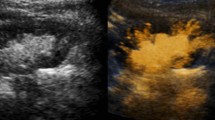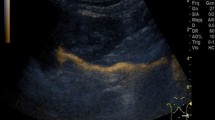Abstract
Background
Voiding urosonography with harmonic imaging (VUS HI) has been introduced as a sensitive and radiation-free imaging method for the diagnosis and follow-up of vesicoureteral reflux (VUR) in children.
Objective
The purpose of this study was to evaluate the sensitivity of VUS HI using a second-generation US contrast agent compared to standard voiding cystourethrography (VCUG).
Materials and methods
A total of 228 children with 463 kidney-ureter units (KUUs) underwent two cycles of VUS HI and two cycles of VCUG at the same session. VUS HI was performed after intravesical administration of 1 ml of a second-generation US contrast agent (sulphur-hexafluoride gas microbubbles, SonoVue, Bracco, Italy). For statistical analysis we used McNemar’s test, Student’s t-test and k coefficient tests.
Results
VUR was shown in 161/463 (34.7%) KUUs, 57 by both methods, 90 only by VUS, and 14 only by VCUG. Concordance in findings regarding the presence or absence of VUR was found in 359/463 (77.5%) KUUs (k=0.40). The difference in the detection rate of reflux between the two methods was significant (P<0.01). More importantly, reflux missed by VCUG was of higher grade (2 grade I, 65 grade II, 19 grade III, 4 grade IV) than that missed by VUS (8 grade I, 5 grade II, 1 grade III).
Conclusion
VUS HI and a second-generation contrast agent improved the identification of reflux in children. Our data reveal a higher sensitivity of the method compared to VCUG. Thus it can be used as an alternative radiation-free imaging method.


Similar content being viewed by others
References
Downs SM (1999) Technical report: urinary tract infections in febrile infants and children. Pediatrics 103:e54
Wennerström M, Hansson S, Hedner T et al (2000) Ambulatory blood pressure 16–26 years after the first urinary tract infection in childhood. J Hypertens 18:485–491
Martinell J, Jodal U, Lidin-Janson G (1990) Pregnancies in women with and without renal scarring after urinary infections in childhood. BMJ 300:840–844
Wennerström M, Hansson S, Jodal U et al (2000) Renal function 16 to 26 years after the first urinary tract infection in childhood. Arch Pediatr Adolesc Med 154:339–345
Craig JC, Irwig LM, Knight JF et al (2000) Does treatment of vesicoureteric reflux in childhood prevent end-stage renal disease attributable to reflux nephropathy? Pediatrics 105:1236–1241
Schneider K, Kruger-Stollfuss I, Ernst G (2001) Paediatric fluoroscopy – a survey of children’s hospitals in Europe. I. Staffing, frequency of fluoroscopic procedures and investigation technique. Pediatr Radiol 31:238–246
Cleveland RH, Constantinou C, Blickman JG (1992) Voiding cystourethrography in children: value of digital fluoroscopy in reducing radiation dose. AJR 158:137–142
Bazopoulos EV, Prassopoulos PK, Damilakis JE et al (1998) A comparison between digital fluoroscopic hard copies and 105-mm spot films in evaluating vesicoureteric reflux in children. Pediatr Radiol 28:162–166
Hernandez RJ, Goodsitt MM (1996) Reduction of radiation dose in pediatric patients using pulsed fluoroscopy. AJR 167:1247–1253
Tremewan RN, Bailey RR, Little PJ et al (1976) Diagnosis of gross vesicoureteric reflux using ultrasonography. Br J Urol 48:431–435
Jequier S, Paitiel H, Lafortune M (1990) Uterovesical jets in infants and children: duplex and color Doppler imaging. Radiology 175:349–353
Blane CE, DiPietro MA, Zerin JM et al (1993) Renal sonography is not a reliable screening examination for vesicoureteral reflux. J Urol 150:752–755
Avni EF, Ayadi K, Rypens F et al (1997) Can careful ultrasound examination of the urinary tract exclude vesicoureteric reflux in the neonate? Br J Urol 70:977–982
Kaneko K, Kuwatsura R, Fukuda Y et al (1994) Contrast sonography for detection of vesicoureteral reflux. Lancet 344:687
Siamplis D, Vasiou K, Giarmenitis S et al (1996) Sonographic detection of vesicoureteral reflux with fluid and air cystography. Comparison with VCUG. Rofo 165:166–169
Darge K, Troeger J, Duetting T et al (1999) Reflux in young patients: comparison of voiding US of the bladder and retrovesical space with echo enhancement versus voiding cystourethrography for diagnosis. Radiology 210:201–207
Darge K, Zieger B, Rohrschneider W et al (2001) Contrast-enhanced harmonic imaging for the diagnosis of vesicoureteral reflux. AJR 177:1411–1415
Bartram U, Darge K (2005) Harmonic versus conventional ultrasound imaging of the urinary tract in children. Pediatr Radiol 35:655–660
Darge K, Beer M, Gordjani N et al (2004) Contrast-enhanced voiding urosonography with the use of a 2nd generation US contrast medium: preliminary results. Pediatr Radiol 34:S97
Ascenti G, Zimbaro G, Mazziotti S et al (2004) Harmonic US imaging of vesicoureteric reflux in children: usefulness of a second generation US contrast agent. Pediatr Radiol 34:481–487
Darge K (2002) Diagnosis of vesicoureteral reflux with ultrasonography. Pediatr Nephrol 17:52–60
Berrocal T, Gaya F, Arjonilla A (2005) Vesicoureteral reflux: can the urethra be adequately assessed by using contrast-enhanced voiding US of the bladder? Radiology 234:235–241
Bosio M, Manzoni GA (2002) Detection of posterior urethral valves with voiding cystourethrosonography with echo contrast. J Urol 168:1711–1715
Darge K, Bruchelt W, Roessling G et al (2003) Interaction of normal saline solution with ultrasound contrast medium: significant implication for sonographic diagnosis of vesicoureteral reflux. Eur Radiol 13:213–218
Papadopoulou F, Tsampoulas C, Siomou E et al (2006) Cyclic contrast-enhanced harmonic voiding urosonography for the evaluation of reflux. Can we keep the cost of the examination low? Eur Radiol 16:2521–2526
Darge K, Troeger J (2002) Vesicoureteral reflux grading in contrast-enhanced voiding urosonography. Eur J Radiol 43:122–128
Lebowitz RL, Olbing H, Parkkulainen KV et al (1985) International system of radiographic grading of vesicoureteric reflux. Pediatr Radiol 15:105–109
Galloy MA, Guillmin F, Couture A et al (2008) Voiding ultrasonography: evaluation of the detection of vesicoureteral reflux based on the review of digital ultrasound clips. Ultraschall Med 29:53–59
Mentzel HJ, Vogt S, John V et al (2002) Voiding urosonography with ultrasonography contrast medium in children. Pediatr Nephrol 17:272–276
Darge K (2008) Voiding urosonography with ultrasound contrast agents for the diagnosis of vesicoureteric reflux in children. I. Procedure. Pediatr Radiol 38:40–53
Robrecht J, Darge K (2007) In-vitro comparison of a 1st and a 2nd generation US contrast agent for reflux diagnosis. Rofo 179:818–825
Darge K (2008) Voiding urosonography with US contrast agents for the diagnosis of vesicoureteric reflux in children. II. Comparison with radiological examinations. Pediatr Radiol 38:54–63
Darge K, Moeller RT, Trusen A et al (2005) Diagnosis of vesicoureteric reflux with low-dose contrast-enhanced harmonic ultrasound imaging. Pediatr Radiol 35:73–78
Kopitzko A, Cornely D, Reither K et al (2004) Low contrast dose voiding urosonography in children with phase inversion imaging. Eur Radiol 14:2290–2296
Author information
Authors and Affiliations
Corresponding author
Rights and permissions
About this article
Cite this article
Papadopoulou, F., Anthopoulou, A., Siomou, E. et al. Harmonic voiding urosonography with a second-generation contrast agent for the diagnosis of vesicoureteral reflux. Pediatr Radiol 39, 239–244 (2009). https://doi.org/10.1007/s00247-008-1080-x
Received:
Revised:
Accepted:
Published:
Issue Date:
DOI: https://doi.org/10.1007/s00247-008-1080-x




